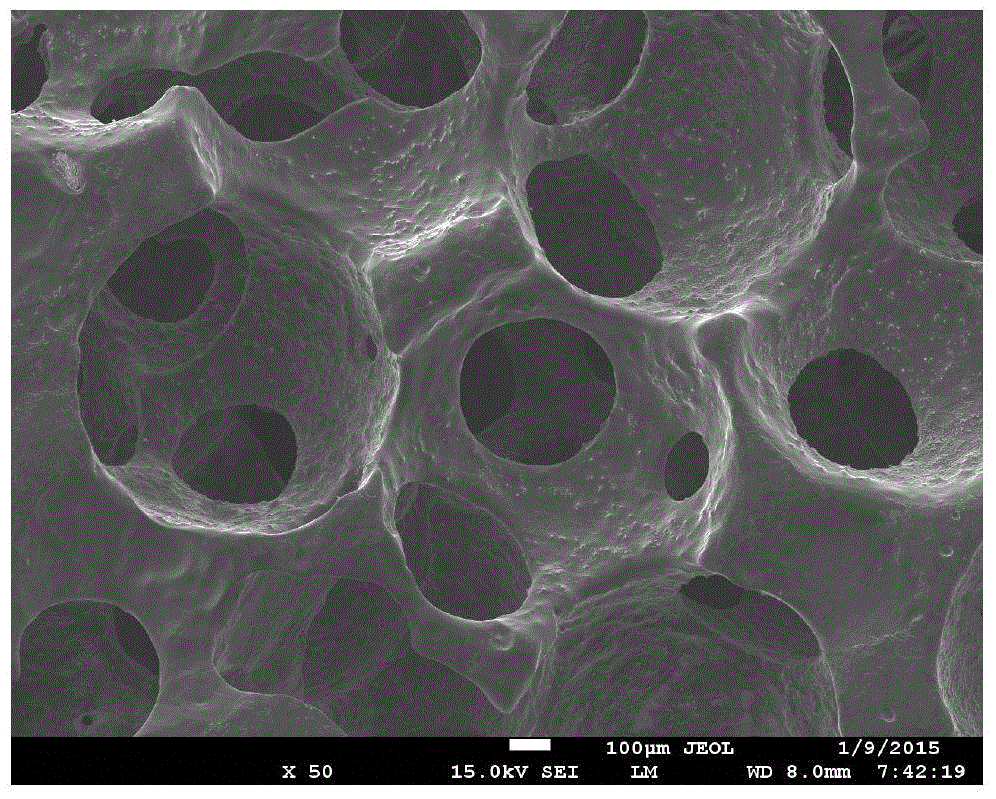Degradable three-dimensional porous magnesium-based biomaterial and preparation method thereof
A three-dimensional porous, biological material technology, used in prosthesis, medical science and other directions, can solve the problems of corrosion of pore-forming agent magnesium matrix metal, can not guarantee the uniformity of pore shape and pore structure connectivity performance, etc. Beneficial for nutrient exchange and high porosity
- Summary
- Abstract
- Description
- Claims
- Application Information
AI Technical Summary
Problems solved by technology
Method used
Image
Examples
Embodiment 1
[0022] This embodiment relates to a degradable three-dimensional open-pore porous magnesium alloy used in the field of tissue engineering. The pore type is spherical and the pore diameter is 400-600 μm. It is 150-250 μm, and the porosity is 75%. Its structure is as figure 1 As shown in the physical figure, it can be seen that the spherical hole type and the connected holes evenly distributed on the hole wall.
[0023] This embodiment relates to the aforementioned degradable three-dimensional open-pore porous magnesium and magnesium alloy preparation method for tissue engineering, and the method includes the following steps:
[0024] Step 1, conduct spark plasma sintering of spherical titanium particles with a size of 400-600 μm, the sintering temperature is 800°C, the heating rate is 20°C / min, the pressure is 5MPa, heat preservation and pressure holding for 3 minutes, and then naturally cool to obtain an open porous titanium ball preform ;
[0025] Step 2: Fill the Mg-5wt.%...
Embodiment 2
[0028] This embodiment relates to a degradable open-pore porous magnesium alloy used for bone tissue engineering scaffolds. The pore type is spherical and the pore diameter is 400-600 μm. It is 250-350 μm, and the porosity is 85%.
[0029] This embodiment relates to the aforementioned degradable open-pore porous magnesium and magnesium alloy preparation method for tissue engineering scaffolds, the method includes the following steps:
[0030] Step 1, conduct discharge plasma sintering of spherical iron particles with a size of 400-600 μm, the sintering temperature is 900°C, the heating rate is 40°C / min, the pressure is 10MPa, heat preservation and pressure holding for 3 minutes, and then naturally cool to obtain a perforated porous iron ball prefabricated body ;
[0031] Step 2: Fill the Mg-3wt.%Nd-0.2wt.%Zn-0.5wt.%Zr-0.5wt.%Ca alloy into the gap of the porous iron ball preform by infiltration casting at 720°C and a pressure of 6MPa , and air-cooled to room temperature to ob...
Embodiment 3
[0034] This embodiment relates to a degradable open-pore porous magnesium alloy used for tissue engineering scaffolds. The pore type is spherical and the pore diameter is 800-1000 μm. ~500μm, the porosity is 90%.
[0035] This embodiment relates to the aforementioned degradable three-dimensional open-pore porous pure magnesium preparation method for tissue engineering scaffolds, and the method includes the following steps:
[0036] Step 1, hot isostatic pressing sintering of spherical titanium particles with a size of 600-800 μm, the sintering temperature is 1000°C, the heating rate is 100°C / min, the pressure is 50MPa, heat preservation and pressure holding for 5 minutes, then naturally cool to obtain open porous iron balls Preform;
[0037] Step 2: Fill the pure magnesium melt into the gap of the porous iron ball preform by percolation casting at 720°C and a pressure of 0.1 MPa, and air-cool to room temperature to obtain a composite block of the preform and pure magnesium
...
PUM
| Property | Measurement | Unit |
|---|---|---|
| pore size | aaaaa | aaaaa |
| compressive strength | aaaaa | aaaaa |
| elastic modulus | aaaaa | aaaaa |
Abstract
Description
Claims
Application Information
 Login to View More
Login to View More - R&D
- Intellectual Property
- Life Sciences
- Materials
- Tech Scout
- Unparalleled Data Quality
- Higher Quality Content
- 60% Fewer Hallucinations
Browse by: Latest US Patents, China's latest patents, Technical Efficacy Thesaurus, Application Domain, Technology Topic, Popular Technical Reports.
© 2025 PatSnap. All rights reserved.Legal|Privacy policy|Modern Slavery Act Transparency Statement|Sitemap|About US| Contact US: help@patsnap.com

